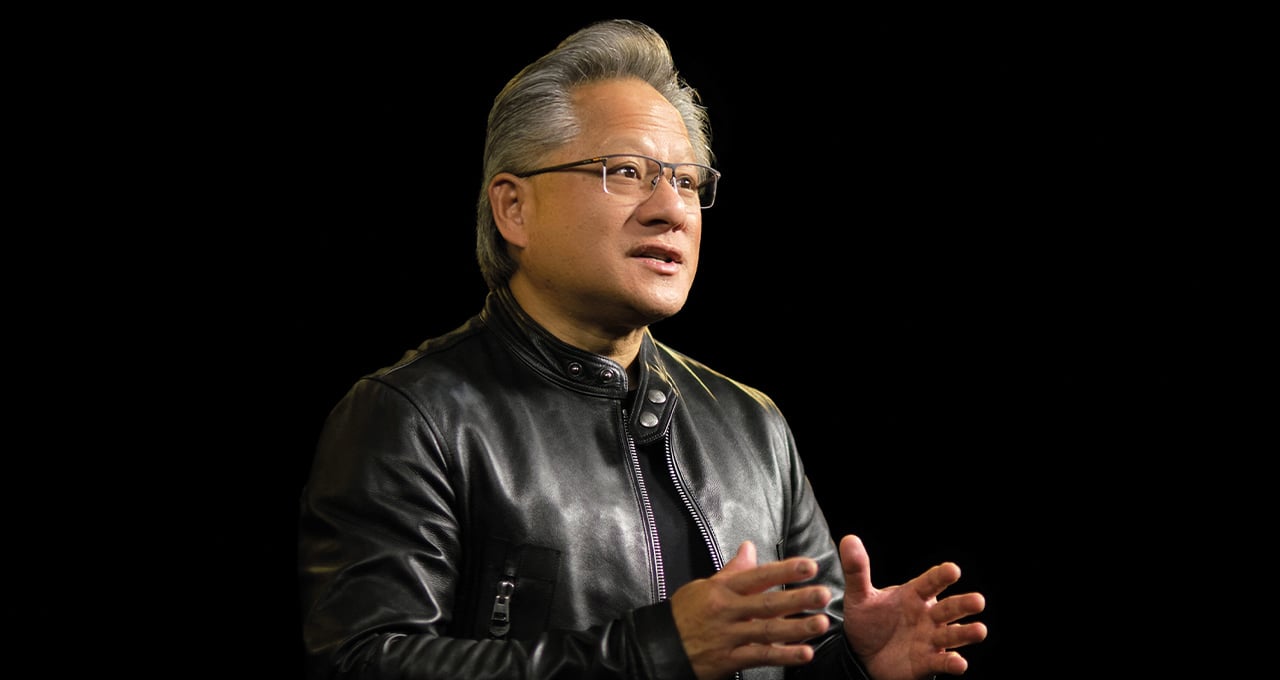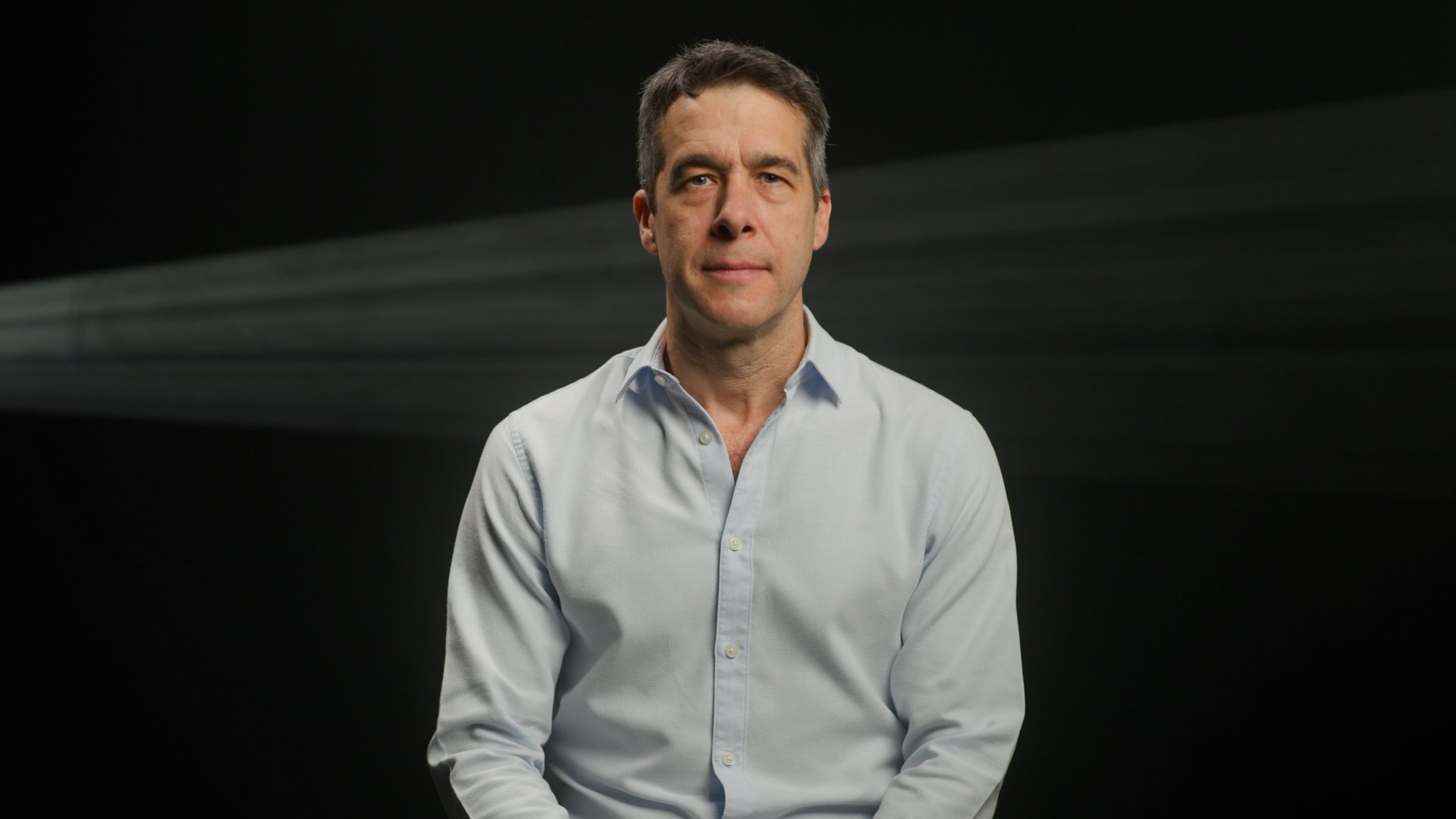
Illustration by Craig Frazier
Please remember that the value of an investment can fall and you may not get back the amount invested. This article originally featured in Baillie Gifford’s Autumn 2023 issue of Trust magazine.
Jensen Huang recently celebrated three decades as NVIDIA’s chief executive. It’s a remarkable achievement, particularly given that many recent advances in artificial intelligence (AI) rest on the foundations of long-term decisions he made years ago – decisions that many doubted at the time.
But Huang’s determination to turn adversity to his advantage has been there from the start. Born in Taiwan, he came to the US aged nine alongside his 11-year-old brother, two years ahead of their parents. Unaware of its nature, a relative enrolled them in a school for troubled children.
Huang discovered that his roommate, who was nearly double his age, had recently been released from jail and was recovering from seven stab wounds. Despite the odds, they became friends: Huang taught his companion to read and was in turn introduced to weightlifting, which became a lifelong passion.
Huang co-founded NVIDIA on his 30th birthday in April 1993 after being persuaded to quit another semiconductor firm. The name came from the ‘NV’ label the founders used to title their computer files. The letters stood for ‘next version’ and inspired them to settle on a shortened form of ‘invidia’ – the Latin for envy. The decision also explains the firm’s widespread use of the colour green.
Video game graphics
Huang’s ex-boss thought so highly of him that he arranged an introduction to the venture capital firm Sequoia. The investment company’s founder prized exceptional technologist leaders who were determined to attack big markets with game-changing products and could overcome setbacks. He looked beyond Huang’s clunky pitch and participated in the firm’s initial $2m funding round.
Huang’s goal was to develop a chip to supercharge video game graphics. It didn’t take long for his resilience to be tested.
NVIDIA’s early technology was based on building images from lots of small four-sided shapes, but a decision by Microsoft led to the industry settling on triangles. For this and other reasons, NVIDIA had to scrap plans for its second-generation chip, lay off most of its workers and start again from scratch, putting it months behind rivals.
Huang turned the challenge into an opportunity by daring to design and trial NVIDIA’s chip in software and then go straight to mass production instead of following the usual process of testing and improving hardware prototypes.
The unprecedented gamble paid off. NVIDIA sold more than a million of the chips within four months of their release in 1997. Moreover, because the California-based company had pioneered a way to bring chips to market twice as fast as usual, it outpaced its rivals when it released more powerful successors.
Valuable mistakes
It wouldn’t be the last time Huang “failed forward” – a strategy he describes as taking a chance on something new, admitting when it isn’t working, adjusting and then pressing onwards, becoming better every time.
NVIDIA’s rapid progress led Microsoft to pick it as the graphics chip supplier for its first Xbox console. When the video games machine was launched in 2001, NVIDIA’s revenues surpassed $1bn, making it the fastest semiconductor company to reach the milestone. But Huang had bigger ambitions than the games market alone.

Jensen Huang is seldom seen in public without a black leather jacket © NVIDIA
Over the following years, he ploughed huge amounts of money into developing CUDA (compute unified device architecture). In simple terms, CUDA allows developers to use NVIDIA’s graphics processing units (GPUs) to do much more than draw images.
The benefit is that GPUs specialise in handling many tasks in parallel, solving complex problems by dividing them into parts and crunching them simultaneously.
CUDA represented a long-term play based on Huang’s belief that GPUs were the key to accelerating scientific discovery. NVIDIA could derive an enduring benefit by being the only firm in its sector to invest deeply in software to unlock that capability.
Artificial intelligence
While specialist researchers found this useful, it didn’t amount to a mass-market opportunity. Then in 2012, the stars aligned. A group of AI researchers made a breakthrough in recognising dogs, boats and other objects in photos, using an NVIDIA-powered neural network – a machine learning system modelled on the human brain.

Spotting the opportunity, NVIDIA extended CUDA, making it easier and faster for others to conduct further AI experiments. Leaps forward in speech recognition, customer recommendation engines and more advanced image recognition followed.
More than three million developers now use CUDA, which works exclusively with NVIDIA’s chips. They have built a huge ecosystem of services around it, making it the industry standard and a bedrock of the company’s competitive advantage.
Scottish Mortgage first invested in NVIDIA in July 2016. It matched our criteria for being an exceptional growth company addressing a huge market opportunity. A large part of the appeal was Huang himself, a founder with a high tolerance for risk regarding projects with potentially huge payoffs.
Over time our appreciation for the stock has grown as we’ve seen NVIDIA’s technology enhance many of our other holdings’ products, including:
- personalised recommendations within Spotify, Netflix and ByteDance’s TikTok
- data centre services from Amazon
- visuals and developer tools for Epic Games’ hit title Fortnite
Generated content
The firm’s stock recently rose to new heights thanks to ‘generative’ AI, which creates text, images and other content at human-like levels. Huang describes last year’s launch of the chatbot ChatGPT as an “inflection point” and its mass adoption as “an iPhone moment”.
It’s too early to know how big the market for generative AI will become. But demand for NVIDIA’s products should continue to benefit from the growing computing power required to train the increasingly complex models involved and the rising number of services that run off them.
Once again, NVIDIA has been quick to adapt. Earlier this year, Huang unveiled DGX Cloud. It provides companies with a way to develop bespoke generative AI models without having to buy their own high-end GPUs.
Instead, they rent use of an ‘AI supercomputer in the cloud’. Huang suggests that companies involved in tackling climate change, drug discovery and chemicals research are among those it will appeal to. And in a very Huang-like fashion, he has partnered with several of the major data centre service providers to offer the service rather than trying to supplant them.
But that’s just the tip of what he describes as a $1tn opportunity to upgrade the sector.
“You’re seeing the beginning of a 10-year transition to basically recycle or reclaim the world’s data centres and build it out as accelerated computing… and the workload is going to be predominantly generative AI,” Huang said in May.
Transport and biology
Looking ahead, transportation has the potential to become a significant revenue stream. Electric cars already feature many more chips than their combustion engine equivalents, and the self-driving future is likely to require additional, higher-end components.
NVIDIA’s Hyperion platform already offers a ‘developer version’ of an energy-efficient in-car computer, in addition to cloud computing facilities to train autonomous driving software and a variety of sensors to help the vehicles make sense of their surroundings. Carmakers can buy the system as a bundle or purchase different parts.
It’s currently a small part of NVIDIA’s business. Still, the firm says it is already working with “several hundred partners”, from large car manufacturers to smaller startups.
Huang also talks up the prospects of a “digital biology revolution”. The idea is that advances in artificial intelligence can be allied to those in genomics to develop new medicines, with NVIDIA’s chips and software accelerating the process.
Both prospects could potentially drive long-term growth at NVIDIA and a range of Scottish Mortgage’s other holdings, including NIO, Nuro, Recursion Pharmaceuticals and Tempus.
Indeed, in July NVIDIA announced it was taking a $50m stake in Recursion and would help the firm train its drug discovery AI models more quickly. Further out, the type of parallel computing Huang pioneered may unlock breakthroughs not yet in sight.
“When technology moves this fast, if you’re not reinventing yourself, you’re just slowly dying,” Huang once remarked. On that basis, NVIDIA is fighting fit thanks to its co-founder’s knack for turning almost every challenge he faces into an opportunity.

Train your own model
Many industries are developing generative AI models, often using NVIDIA’s products, to create and analyse text and images:
Retail: Amazon is developing a large language model to enhance shopping and other experiences on its Alexa-powered smart speakers. A few companies have also started to use AI models to create items from scratch from customers’ text-based descriptions, including T-shirt image designs.
Law: Several startups already offer services built on ChatGPT’s technology to summarise court decisions, highlight risky contract clauses and answer complex case law questions in plain language. But large law firms may decide there’s an advantage in training proprietary models on their archives.
Healthcare: Researchers at New York University have trained a model on clinical notes to predict which hospital patients are at the greatest risk of readmission within a month of being discharged. Others are developing models to develop new drugs and artificially generate body scans to deepen understanding of rare diseases.
Financial services: Bloomberg is developing a model to help users query its vast financial database and track investor sentiment by analysing comments about traded stocks.
Education: Students and teachers are already using various AI models to write and mark homework. But educational institutions are also developing new ones. For example, the University of Zurich has created a tool to help researchers analyse articles written in the country’s four official languages, including Romansh.

NVIDIA is also held by the Baillie Gifford US Growth Trust and The Monks Investment Trust.
Important information
Investments with exposure to overseas securities can be affected by changing stock market conditions and currency exchange rates.
The views expressed in this article should not be considered as advice or a recommendation to buy, sell or hold a particular investment. The article contains information and opinion on investments that does not constitute independent investment research, and is therefore not subject to the protections afforded to independent research.
Some of the views expressed are not necessarily those of Baillie Gifford. Investment markets and conditions can change rapidly, therefore the views expressed should not be taken as statements of fact nor should reliance be placed on them when making investment decisions.
Baillie Gifford & Co Limited is wholly owned by Baillie Gifford & Co. Both companies are authorised and regulated by the Financial Conduct Authority and are based at: Calton Square, 1 Greenside Row, Edinburgh EH1 3AN.
The investment trusts managed by Baillie Gifford & Co Limited are listed on the London Stock Exchange and are not authorised or regulated by the Financial Conduct Authority.
A Key Information Document is available by visiting bailliegifford.com
58808 10035780



